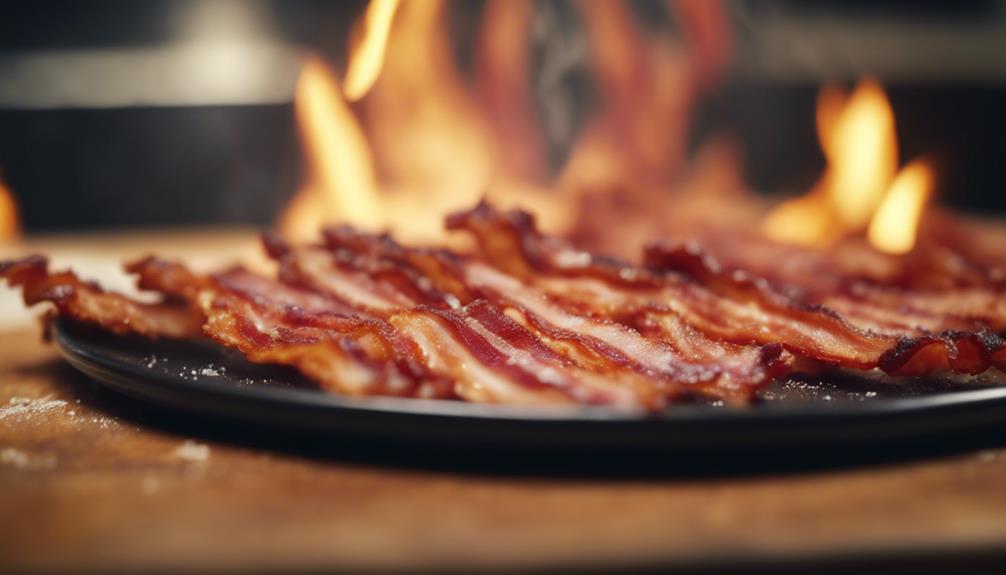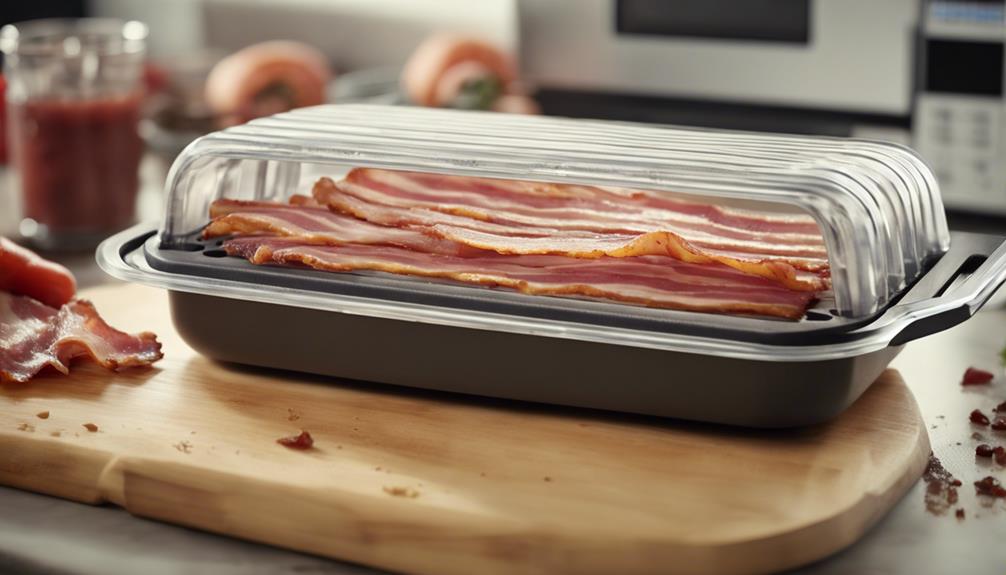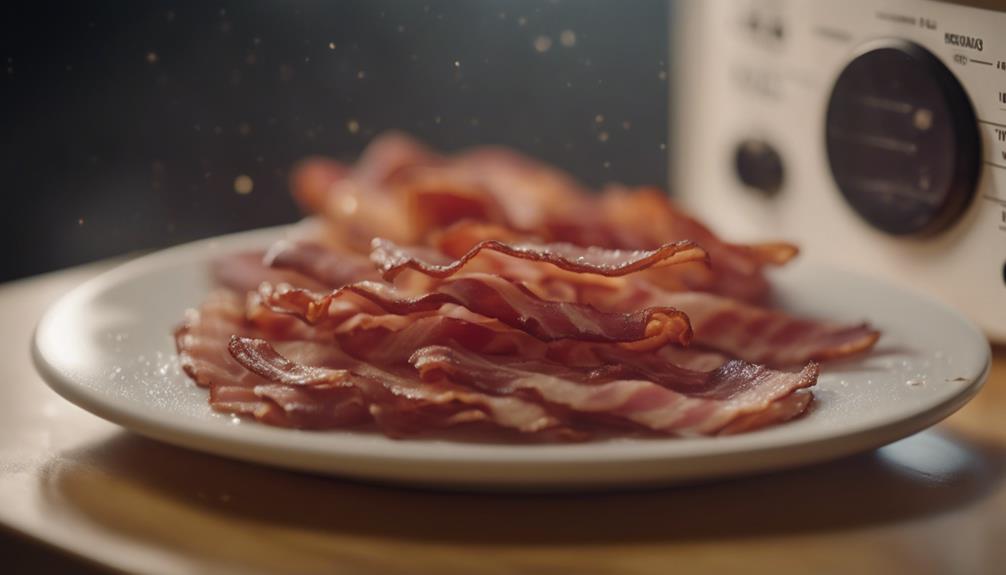Yes, you can microwave bacon to achieve a balance of crispy yet tender strips. Microwaving bacon offers convenience and a mess-free preparation method. While some argue that it compromises the taste and texture, by using the right technique, you can achieve delicious results.
The secret lies in using a microwave-safe bacon tray or a microwave-safe plate lined with paper towels to absorb excess grease. By cooking the bacon in short bursts and flipping it halfway through, you can ensure even cooking and crispiness. Additionally, microwaving bacon allows you to control the cooking time, resulting in customized levels of crispiness.
So, while it may not be the traditional way of cooking bacon, microwaving can be a quick and easy method to enjoy this breakfast favorite.
Key Takeaways
- Microwaving bacon is a quick, efficient cooking method.
- Adjust cook time for desired crispiness levels.
- Utilize paper towels for grease management and crisp bacon.
- Proper technique ensures delicious microwaved bacon results.
Advantages of Microwaving Bacon
Microwaving bacon offers several advantages, making it a convenient and efficient cooking method for preparing this popular breakfast food. The cook time is notably quick, typically taking only 3 to 6 minutes to achieve crispy bacon.
Using layers of paper towels helps reduce mess by absorbing excess bacon fat efficiently. This method is suitable for smaller batch sizes, accommodating 4 to 6 slices at once.
Additionally, microwaving bacon is a hands-off approach, requiring minimal supervision. To avoid overcooking, it's essential to adjust the cooking time based on the thickness of the bacon slices and the desired level of crispiness.
Disadvantages of Microwaving Bacon
When preparing bacon in the microwave, one notable drawback is the potential lack of achieving optimal crispiness compared to alternative cooking methods such as stovetop or oven cooking.
Here are three key disadvantages to microwaving bacon:
- Environmental Impact: The use of paper towels in microwaving bacon may not be environmentally sustainable due to the waste generated.
- Monitoring Required: It is crucial to monitor bacon while microwaving to prevent burning and overcooking, which can be challenging compared to other cooking methods.
- Loss of Rendered Bacon Fat: Microwaving bacon does not allow for saving rendered bacon fat for later use in recipes, impacting the flavor profile of dishes that rely on this ingredient.
Proper Microwave Bacon Cooking Time

When cooking bacon in the microwave, it is crucial to adhere to the recommended cooking times based on the type of bacon and wattage of the microwave. Following these guidelines ensures that the bacon is cooked to the desired level of crispiness without being overdone.
Additionally, adjusting the cooking time in 30-second intervals allows for customization to achieve the perfect texture.
Cooking Time Guidelines
To achieve optimal results when microwaving bacon, adhere to the recommended cooking time guidelines for your microwave's wattage. Here are some key points to consider:
- Regular bacon typically requires 4 minutes of microwave cooking time.
- Thick-cut bacon may need 5 minutes to cook thoroughly in the microwave.
- These cooking times are consistent for 1000 and 1200-watt microwaves.
Checking Bacon Doneness
For optimal results in microwaving bacon, ensuring proper doneness is essential to achieve a balanced texture and flavor profile. When checking bacon doneness, look for a uniform brown color to indicate that it is cooked to perfection. Proper microwave bacon cooking time ensures that the fat has rendered, and the bacon is crispy without being overly dry. To help absorb excess fat and prevent sogginess, place the cooked bacon on paper towels in between layers. This method allows the bacon to maintain its crispiness without becoming greasy. By following these steps, you can enjoy delicious microwave-cooked bacon that is both flavorful and satisfying.
| Do This | Avoid This | Remember This |
|---|---|---|
| Check for uniform brown color | Overcooking bacon | Properly rendered fat |
| Place on paper towels in between layers | Undercooking bacon | Balanced texture |
Adjusting for Crispiness
Achieving the desired level of crispiness in microwave-cooked bacon can be fine-tuned by adjusting the cooking time in incremental intervals to suit individual preferences. To adjust for crispiness effectively, consider the following:
- Layer bacon between paper towels: Placing paper towels above and below the bacon helps absorb excess grease, contributing to a crispier texture.
- Monitor cooking time: Regularly check the bacon's progress in the microwave to prevent overcooking. Adjust cooking time accordingly for optimal crispiness.
- Let bacon rest: Remember that bacon continues to crisp up as it cools after being removed from the microwave. Account for this post-cooking factor when adjusting for desired crispiness.
Essential Tools for Microwaving Bacon

When microwaving bacon, having the right tools is essential for optimal results. To start, use a microwave-safe plate to cook the bacon evenly. Line the plate with paper towels to absorb excess grease during cooking, resulting in a crispier texture.
Avoid overlapping bacon slices on the plate to ensure that each piece cooks thoroughly. Consider using a specialized microwave bacon cooker for a more tailored cooking experience. Additionally, adjusting the cooking time based on the bacon's thickness and desired level of crispiness is crucial.
Step-by-Step Bacon Microwaving Guide
To optimize the process of microwaving bacon, it is essential to progress from preparing the necessary tools to executing a meticulous step-by-step guide.
- Line a microwave-safe plate with paper towels for easy cleanup.
- Lay bacon slices in a single layer on the plate.
- Top the bacon with more paper towels to absorb grease while cooking.
Draining Excess Fat After Microwaving

After microwaving bacon, it is imperative to transfer it to fresh paper towels to drain excess fat effectively. The paper towels play a crucial role in absorbing the rendered bacon fat, providing a healthier option compared to consuming the excess grease.
This step not only helps in draining the excess fat but also ensures that the bacon remains crispy and avoids becoming soggy. It is essential to handle the bacon carefully to prevent any potential spills of hot grease, which can lead to burns or messes.
Frequently Asked Questions
Can You Use Any Type of Bacon in the Microwave, or Are Certain Types Better Suited for This Method of Cooking?
Certain types of bacon, like mid-priced options, are better suited for microwaving as they achieve optimal crispiness. Experiment with different cuts, such as turkey bacon alternatives, for varying textures. Adjust seasoning, cooking times, and consider flavor enhancements for a personalized experience.
Is It Safe to Microwave Bacon Without a Microwave-Safe Cover or Plate?
When considering microwave safety, using a microwave-safe plate is crucial for even cooking and preventing damage. This practice ensures that the dish can withstand the generated heat without leaching harmful chemicals. Always follow manufacturer guidelines for safe use.
Can You Reheat Leftover Microwaved Bacon, and if So, What Is the Best Method to Do So?
When reheating leftover microwaved bacon, the best method involves placing it between paper towels on a microwave-safe plate. Microwave on high for 10-20 seconds, adjusting for preferred warmth. Vary time based on bacon amount and thickness to avoid dryness or toughness.
Are There Any Special Tips or Techniques for Preventing Bacon From Becoming Too Crispy or Burnt in the Microwave?
To maintain the ideal balance between crispy and chewy bacon in the microwave, adjust cooking time based on bacon thickness and power levels. Flipping bacon halfway through, covering it to reduce splatter, and savoring the enticing aroma are essential steps.
How Does Microwaving Bacon Compare to Other Cooking Methods in Terms of Taste and Texture?
When comparing microwaving bacon to other methods, flavor profiles differ slightly, with microwaved bacon showcasing a softer texture. Cooking time can vary based on bacon thickness and microwave wattage. Achieving the desired level of crispiness, chewiness, and seasoning may require adjustments.
Conclusion
In conclusion, microwaving bacon offers a convenient and efficient way to cook this breakfast favorite. While it may not provide the same crispy texture as traditional methods, it eliminates oil splatter and reduces excess fat for a healthier option.
By following proper cooking times and using essential tools, you can easily enjoy delicious bacon with minimal cleanup. Remember, microwaving bacon is like a time-saving sizzle in your morning routine.


